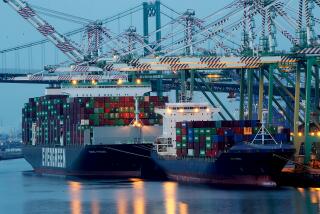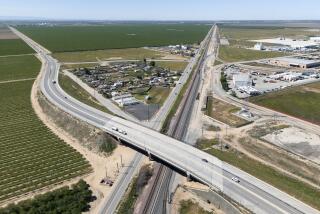It Ain’t Pretty, but It Delivers the Goods
For clutter, for noise, for sheer nonstop action deep in the guts of industrial Southern California, few places come close to massive Hobart Yard.
A rail hub since long before the Wright brothers flew, Hobart has grown only more crowded and forbidding with the rise of Pacific Rim trade. The yard is two miles long, and if there is a single blade of grass, it is doomed to be crushed by wheels or poisoned by diesel fumes. Even the asphalt has a hard time of it: patched, rutted, crisscrossed with painted-over lines.
Yellow concrete barriers known as K-rails form makeshift pathways for trucks that snort and rumble in a dance that goes on 24 hours a day. Trains also come and go around the clock--on average, every 52 minutes. At night they drone in under the pale glow of rickety-looking light towers.
No passengers ride these mile-long trains, except when an occasional hobo finds a way to bed down under the overhang of a cargo container. The single- and double-stack trains are strictly for commodities: enough computers, clocks, bicycles, jeans, ovens, grain, soap and chemicals to supply whole cities.
“We simply move millions of tons of freight every day--that’s all we do,” said Chuck Potempa, director of facilities operation for the Burlington Northern and Santa Fe Railway, which operates the yard in Los Angeles, Vernon and the City of Commerce. “People fail to ask the question: ‘How does my stuff get from China to Wal-Mart?’ This is how it happens.”
Hobart is a billion-dollar locus in a global network of steamship lines, railways and big-rig trucks. According to Potempa, this is the busiest yard ever created for transferring train cargo to trucks, and vice versa. A slightly smaller yard, owned by Union Pacific Railroad, operates across the street.
Much of the freight arrives at the ports of Long Beach and Los Angeles, travels by freeway to Hobart, then is sent by rail to points east, including East Coast ports that will ferry it to Europe. Other freight leaves Eastern and Midwestern depots and flows into Hobart, where trucks collect it and carry it to local stores and warehouses.
Like plumbing, Hobart is unvarnished and purely functional. Most people see it only while driving past on the Long Beach Freeway, just south of the Santa Ana Freeway. The yard extends to the west in a seemingly endless landscape of rails and big-rig containers.
Inside its guarded gates, Hobart is a surreal world. Potempa compares it to an aircraft carrier--huge, flat, complicated, dangerous. Things happen for which there is no explanation.
A switchman walking the tracks a couple of years ago looked down and discovered a hand grenade. No one could figure out where it came from or why. The bomb squad whisked it away.
Fires erupt. Intruders have to be run off. Beehives have to be destroyed. Not long ago a police chase interrupted business at 2 in the morning--bad luck for a fugitive thinking he could find his way back out of the labyrinth.
The physical scale is staggering. In one area stand enormous steel racks, like ski racks outside a winter lodge. Leaning against them are hundreds of entire big-rig chassis--the wheels and undercarriages after the metal containers are removed.
As many as 18,000 chassis, some as long as 53 feet, can be stored at a time. Each is lifted and placed on end by an oversized, forklift-like truck with huge clamping arms.
Major shipping companies not only own their own ships but the containers and truck chassis as well. They contract with the railways and trucking companies to move those containers over land.
“One of the complexities of operating this facility is we have to have several chassis pools,” Potempa said. “So a Maersk container ends up on a Maersk chassis, a Yang Ming [container] ends up on a Yang Ming chassis, a Hanjin ends up on a Hanjin chassis.”
The dawn of the container era, in the 1980s, along with the extraordinary growth of trade at Pacific ports has created traffic through Hobart that was unimaginable a few years ago, Potempa said. Cargo volume is measured in “lifts,” the number of times a container or trailer is lifted onto or off of a train. In 2000 alone, the yard logged more than 1 million lifts.
“In ‘95, if you’d have [predicted that], you’d have been laughed off the property,” Potempa said.
Lifting is done mainly by 40-foot-tall, mobile, bow-legged cranes that can straddle the tracks. Outbound containers are lined up beside a train of flatcars and a crane passes over them, methodically lifting each container, shifting it into position and dropping it gently on the rail car. Workers secure each container in place and double- and triple-check its destination.
Keeping track of everything is the trickiest part of running the yard. A single train can carry up to 220 containers, and the yard, at busy peaks, may end up with as many as seven trains at various stages of being loaded or unloaded.
Containers and trailers are constantly being moved around by miniature rigs called hostlers. Some containers have to be moved to the tracks for shipment; others have to be shuttled to parking lots, where they are picked up and hauled away by larger rigs. On a single day this year, a record 4,200 containers and trailers were scattered around the yard.
Computers try to follow their movements. In every crane and hostler is a terminal. Numbers are logged in. Three “lot checkers” do nothing but drive around in pickup trucks, keying in container and parking-space numbers. The information--constantly updated in real time--is not quite enough, so crews also rely on a more archaic technology: They scrawl shorthand notations on the sides of the containers in yellow chalk. Two measly letters--KC--may ensure that an outbound container reaches Kansas City even if someone misreads a screen.
Error rates are minuscule. A container winds up in the wrong city about one time in 80,000, Potempa said.
A different sort of monitoring is designed to keep the yard from becoming jammed up with too many trains. A train master in a three-story control tower watches computer diagrams of trains rolling throughout the West. As many as 21 trains have been headed west toward Hobart in a 24-hour period.
“You have to gauge your westbounds and make decisions on whether to hold trains west of Barstow or east of Barstow,” said Van Stewart, a terminal manager who supervises the train masters. Delays and even derailments can throw schedules into disarray, one reason the train masters hold planning meetings every three to four hours, around the clock.
“If you’re not properly planning, what you have is chaos,” Stewart said. “It can become helter-skelter out there.”
More to Read
Sign up for Essential California
The most important California stories and recommendations in your inbox every morning.
You may occasionally receive promotional content from the Los Angeles Times.










